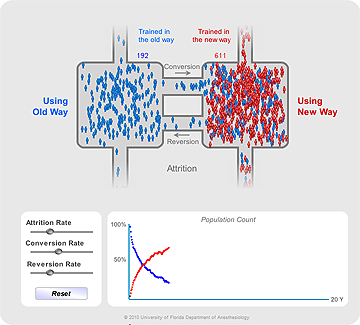
Simulation of Change – Adopting a New Way
To reference this educational web simulation according to the APA style for Web references, use: Lampotang S, Lizdas D. (2010): Simulation of Change – Adopting a New Way. Retrieved <insert date of retrieval here>, from University of Florida Department of Anesthesiology Virtual Anesthesia Machine Web site:
Simulation: This simulation represents how a population adopts a new idea over time. Consider two ways of doing something: an old method and a new method. These two methods are represented by two compartments. Blue figures represent individuals who were initially trained to use the old method. Red figures represent individuals who were initially trained to use the new method. The figures have to be in one or the other compartments; each compartment contains everyone currently practicing the old or new method, respectively. At the beginning of the simulation, everyone has been trained in and is using the old method, and therefore all figures are blue and in the old method compartment. |
||
|
We assume a constant number of individuals. When figures leave the field for whatever reason (attrition) they are replaced. Attrition rate is user adjustable. We assume that a figure leaving the field will train an individual in whatever method they were using when they left the field. The number of figures using each method is plotted over time. At the default settings, complete change occurs over roughly a decade in this stochastic simulation. This simulation is a modification of a two compartment pharmacokinetic stochastic visualization. |
||
